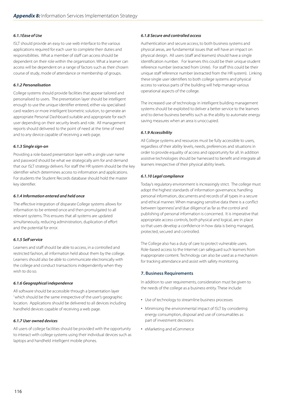
Appendix 8: Information Services Implementation Strategy
116
6.1.1Ease of Use
ISLT should provide an easy to use web interface to the various
applications required for each user to complete their duties and
responsibilities. What a member of staf can access should be
dependent on their role within the organisation. What a learner can
access will be dependent on a range of factors such as their chosen
course of study, mode of attendance or membership of groups.
6.1.2 Personalisation
College systems should provide facilities that appear tailored and
personalised to users. The presentation layer should be intelligent
enough to use the unique identii er entered, either via specialised
card readers or more intelligent biometric solution, to generate an
appropriate Personal Dashboard suitable and appropriate for each
user depending on their security levels and role. All management
reports should delivered to the point of need at the time of need
and to any device capable of receiving a web page.
6.1.3 Single sign-on
Providing a role-based presentation layer with a single user name
and password should be what we strategically aim for and demand
that our ISLT strategy delivers. For staf the HR system should be the key
identii er which determines access to information and applications.
For students the Student Records database should hold the master
key identii er.
6.1.4 Information entered and held once
The ef ective integration of disparate College systems allows for
information to be entered once and then promulgated to all
relevant systems. This ensures that all systems are updated
simultaneously, reducing administration, duplication of ef ort
and the potential for error.
6.1.5 Self service
Learners and staf should be able to access, in a controlled and
restricted fashion, all information held about them by the college.
Learners should also be able to communicate electronically with
the college and conduct transactions independently when they
wish to do so.
6.1.6 Geographical independence
All software should be accessible through a 'presentation layer
' which should be the same irrespective of the user's geographic
location. Applications should be delivered to all devices including
handheld devices capable of receiving a web page.
6.1.7 User owned devices
All users of college facilities should be provided with the opportunity
to interact with college systems using their individual devices such as
laptops and handheld intelligent mobile phones.
6.1.8 Secure and controlled access
Authentication and secure access, to both business systems and
physical areas, are fundamental issues that will have an impact on
physical design. All users (staf and learners) should have a single
identii cation number. For learners this could be their unique student
reference number (extracted from Unite). For staf this could be their
unique staf reference number (extracted from the HR system). Linking
these single user identii ers to both college systems and physical
access to various parts of the building will help manage various
operational aspects of the college.
The increased use of technology in intelligent building management
systems should be exploited to deliver a better service to the learners
and to derive business benei ts such as the ability to automate energy
saving measures when an area is unoccupied.
6.1.9 Accessibility
All College systems and resources must be fully accessible to users,
regardless of their ability levels, needs, preferences and situations in
order to provide equality of access and opportunity for all. In addition
assistive technologies should be harnessed to benei t and integrate all
learners irrespective of their physical ability levels.
6.1.10 Legal compliance
Today's regulatory environment is increasingly strict. The college must
adopt the highest standards of information governance, handling
personal information, documents and records of all types in a secure
and ethical manner. When managing sensitive data there is a conl ict
between 'openness' and 'due diligence' as far as the control and
publishing of personal information is concerned. It is imperative that
appropriate access controls, both physical and logical, are in place
so that users develop a coni dence in how data is being managed,
protected, secured and controlled.
The College also has a duty of care to protect vulnerable users.
Role-based access to the Internet can safeguard such learners from
inappropriate content. Technology can also be used as a mechanism
for tracking attendance and assist with safety monitoring.
7. Business Requirements
In addition to user requirements, consideration must be given to
the needs of the college as a business entity. These include:
Use of technology to streamline business processes
Minimising the environmental impact of ISLT by considering
energy consumption, disposal and use of consumables as
part of investment decisions
eMarketing and eCommerce
•
•
•